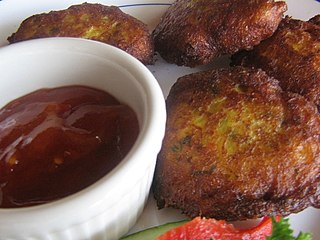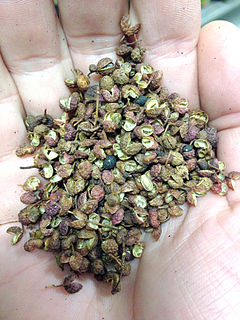
Indonesian cuisine is a collection of various regional culinary traditions that formed the archipelagic nation of Indonesia. There are a wide variety of recipes and cuisines in part because Indonesia is composed of approximately 6,000 populated islands of the total 17,508 in the world's largest archipelago, with more than 600 ethnic groups. Many regional cuisines exist, often based upon indigenous culture with some foreign influences. Indonesia has around 5,350 traditional recipes, with 30 of them considered the most important. Indonesia's cuisine may include rice, noodle and soup dishes in modest local eateries to street-side snacks and top-dollar plates.

Malay cuisine is the cooking tradition of ethnic Malays of Southeast Asia, residing in modern-day Malaysia, Indonesia, Singapore, Brunei, Southern Thailand and the Philippines as well as in Cocos Islands, Sri Lanka and South Africa. Different Malay regions are all known for their unique or signature dishes—Pattani, Terengganu and Kelantan for their nasi dagang, nasi kerabu and keropok lekor; Pahang and Perak for its durian-based cuisine, gulai tempoyak; Kedah and Penang for their northern-style asam laksa and rojak; Satun and Perlis for its bunga kuda dessert; Negeri Sembilan for its lemak-based dishes; Malacca for their spicy cincalok; Singapore for their rojak bandung and roti prata; Riau for its ikan patin dishes, gulai ikan patin and asam pedas ikan patin; the Riau Islands for their sup ikan; West Sumatra for its rendang and lemang; Deli Malays of North Sumatra for their nasi goreng teri medan and gulai ketam; Jambi for its ikan mas panggang and tempoyak; Palembangese Malays of South Sumatra for their pempek, mi celor and nasi minyak; Bangka Belitung for its siput gonggong and terang bulan; West Kalimantan and Sarawak for its bubur pedas and ayam pansuh; Brunei for their nasi katok and unique ambuyat dish; Sri Lankan Malays of Sri Lanka for its kalu dodol and watalappam; and Cape Malays of South Africa for their bobotie, boeber and koe'sister.

Hokkien mee is a Southeast Asian dish, popular in Indonesian, Malaysian, Singaporean and Thai cuisines, that has its origins in the cuisine of China's Fujian (Hokkien) province. There are three distinct types of Hokkien mee. The Singaporean variant consists of egg noodles and rice noodles stir-fried with egg, slices of pork, prawns and squid, and served and garnished with vegetables, small pieces of lard, sambal sauce and lime.

Shrimp paste or prawn sauce is a fermented condiment commonly used in Southeast Asian and Southern Chinese cuisines. It is primarily made from finely crushed shrimp or krill mixed with salt, and then fermented for several weeks. They are either sold in their wet form or are sun-dried and either cut into rectangular blocks or sold in bulk. It is an essential ingredient in many curries, sauces and sambal. Shrimp paste can be found in many meals in Indonesia, Cambodia, Laos, Malaysia, Myanmar, the Philippines, Singapore, Thailand, and Vietnam. It is often an ingredient in dip for fish or vegetables.

Rice vermicelli are a thin form of rice noodles. They are sometimes referred to as rice noodles or rice sticks, but they should not be confused with cellophane noodles, a different Asian type of vermicelli made from mung bean starch or rice starch rather than rice grains itself.

Chili sauce and chili paste are condiments prepared with chili peppers.

Peranakan cuisine or Nyonya cuisine comes from the Peranakans, descendants of early Chinese migrants who settled in Penang, Malacca, Singapore and Indonesia, inter-marrying with local Malays. In Baba Malay, a female Peranakan is known as a nonya, and a male Peranakan is known as a baba. The cuisine combines Chinese, Malay, Javanese and other influences.

Peanut sauce, satay sauce, bumbu kacang, sambal kacang, or pecel is an Indonesian sauce made from ground roasted or fried peanuts, widely used in cuisines worldwide.

Dried shrimp are shrimp that have been sun-dried and shrunk to a thumbnail size. They are used in many East Asian, Southeast Asian and South Asian cuisines, imparting a unique umami taste. A handful of shrimp is generally used for dishes. The flavors of this ingredient are released when allowed to simmer.

Babi panggang refers to a variety of recipes for Indonesian grilled pork recipes, 'babi' meaning pig or pork, and 'panggang' meaning grilled or roasted in the Indonesian language.

Javanese cuisine is the cuisine of Javanese people, a major ethnic group in Indonesia, more precisely the province of Central Java, Yogyakarta and East Java. Though the cuisine of Sumatra is known for its spiciness with notable Indian and Arabic influences, Javanese cuisine is more indigenously developed and noted for its simplicity. Some of Javanese dishes demonstrate foreign influences, most notably Chinese.

Arsik is an Indonesian spicy fish dish of the Batak Toba and Mandailing people of North Sumatra, usually using the common carp.

Bumbu is the Indonesian word for a blend of spices and it commonly appears in the names of spice mixtures, sauces and seasoning pastes. The official Indonesian language dictionary describes bumbu as "various types of herbs and plants that have a pleasant aroma and flavour — such as ginger, turmeric, galangal, nutmeg and pepper — used to enhance the flavour of the food."

Batak cuisine is the cuisine and cooking traditions of Batak ethnic groups, predominantly found in North Sumatra region, Indonesia. Batak cuisine is part of Indonesian cuisine, and compared to other Sumatran cuisine traditions, it is more indigenously preserved. One characteristic of Batak cuisine is its preference to andaliman as the main spice. That is why andaliman in Indonesia sometimes dubbed as "Batak pepper".

Sichuan pepper is a spice commonly used in the Sichuan cuisine of China's southwestern Sichuan Province. When eaten it produces a tingling, numbing effect due to the presence of hydroxy-alpha sanshool in the peppercorn. It is commonly used in Sichuan dishes such as mapo doufu and Chongqing hot pot, and is often added together with chili peppers to create a flavor known as málà.

Sambal is an Indonesian chili sauce or paste typically made from a mixture of a variety of chili peppers with secondary ingredients such as shrimp paste, garlic, ginger, shallot, scallion, palm sugar, and lime juice. Sambal is an Indonesian loan-word of Javanese origin (sambel). It is native to the cuisines of Indonesia, and popular in Malaysia, Sri Lanka, Brunei and Singapore. It has also spread through overseas Indonesian populations to the Netherlands and Suriname.

Seblak is an Indonesian savoury and spicy dish, originating from Sundanese cuisine in the western part of Java, made of wet krupuk cooked with protein sources in spicy sauce. Seblak is a specialty of Bandung city, West Java, Indonesia. Seblak can be acquired from restaurants, warungs or gerobak (cart) street vendors. It is one of the most popular street foods in Indonesia, especially in Bandung and Jakarta.

Balado is a type of hot and spicy bumbu found in Minang cuisine of West Sumatra, Indonesia. Balado sauce is made by stir frying ground red hot chili pepper with other spices including garlic, shallot, tomato and key lime juice in coconut or palm oil.

Mie Gomak is a Batak thick spicy noodle soup dish served in a coconut milk and andaliman-based broth, specialty of Toba Batak region of North Sumatra, Indonesia. Other that traditional Batak lands surrounding Lake Toba, this dish is also a specialty of the Sibolga and Tapanuli area. Unlike common Indonesian noodles, the type of noodle used in this dish is a thick one called mie lidi, quite similar to spaghetti pasta, thus mie gomak is often described as Batak style spaghetti. Mie gomak is quite similar to Mie Aceh from neighbouring province.


















